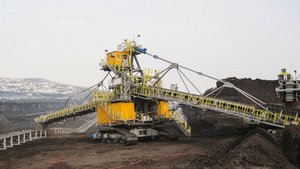Unknown Facts About Overland Conveyors
Table of ContentsFacts About Overland Conveyors UncoveredSome Of Overland ConveyorsUnknown Facts About Overland ConveyorsGetting The Overland Conveyors To WorkOverland Conveyors Can Be Fun For Anyone
Belt Conveyors Belt conveyors are one of the most usual and most basic kind of conveyor and can have variable speeds. They have a relocating belt that rests on a steel frame that sustains the belt and also the materials being relocated. Ones that have a supporting framework below are referred to as moving design.Gravity Roller Conveyors Gravity roller conveyors have a collection of similarly spaced rollers attached to a side framework. The placement of the rollers offers a surface area to place products for motion. If a gravity roller conveyor is tilted or mounted on an angle, products move by gravity. Though items of differing dimensions can be packed on a gravity roller conveyor, employees require to be cautious of bigger materials encountering smaller sized ones.
Chain Conveyors Chain conveyors can have 2 or several sets of chains that reach all-time low of things to be relocated. The products hinge on the chains as they are moved. Chain driven conveyors are excellent for items with irregular lower surfaces or ones that are very heavy.
Due to the types of items chain conveyors relocate, they run extremely gradually. Motorized Roller Conveyors Motorized roller conveyors use electric motors, positioned along the conveyor structure, to power uniformly spaced rollers.
The Main Principles Of Overland Conveyors
In some systems, there is a sensor that starts as well as stops the motor to stay clear of items getting loaded with each other. Slat Conveyors Slat conveyors have the very same layout as chain conveyors with level slats linked to the chain. In some means, they resemble belt conveyors with slats changing the belt.
The unit shields the track from wear and also makes it easier to put bends and also contours in the system. Open Track Conveyors - Open up track conveyors do not cover the track and also use I beams as the track. They are very easy to mount and also optimal for long straight arrangements. Chain Overhead Conveyors - Chain expenses conveyors use a continual powered chain that leaves a track.
In other designs where necklaces are not made use of, pusher canines might be used to move carts along a 2nd track positioned beneath the chain track. This kind of system is described as power as well as totally free. Monorail Conveyors Monorail communicating systems have service providers to move products and also are suitable for use over lengthy ranges.
Monorail conveyors utilize the room over the manufacturing location. In some layouts, the service providers lower to the level of manufacturing and after that rise, out of the way. Power as well as Free Conveyors Power and also complimentary communicating systems are developed to relocate components through the manufacturing as well as assembly procedure.
Some Known Incorrect Statements About Overland Conveyors

Upside down Conveyors Inverted conveyors are floor installed as well as can be utilized as power and also cost-free conveyors. They usually have a drive system that does not include a belt or chain. Paternoster Conveyors Paternoster conveyors are an upright sharing system that makes use of equal spaced lots providers linked to a chain drive, which relocates a constant loop.
Chute go Conveyors Chute conveyors have a smooth flat surface constructed from timber, steel, or plastic that is established on an angle in a framework, which can be right, spiral, or circular. Products are glided down the surface - Overland Conveyors. Screw Conveyors Screw conveyors are made use of to relocate bulk compounds such as granular items, chips, as well as loosened materials.
The chain is capable of flexing along the horizontal axis enabling it to make straight turns and also can making vertical contours. The various types of spins and also turns a COE makes allows it to be extra versatile than standard chain driven conveyors. Skid Conveyor Skid conveyors are one more kind of flooring placed conveyor that moves products on fixtures that have longitudinal runners called skids with travel being longitudinally and also transversely.
Indicators on Overland Conveyors You Need To Know
Skid conveyor systems are valued for the efficiency and peaceful setting of transportation. The variants in skid conveyor systems are because of the lots of elements and also control systems that can be included. Rubbing Conveying System A rubbing communicating system makes use of a motor to drive a rubbing wheel made of non metallic material to develop driving force.
Friction sharing systems are a risk-free choice to power as well as totally free systems with the major advantage of operating cleaner and quieter. They have a flexible format, system building, easy rate altering, can quickly be expanded, and reduced overall expense. The main purpose for friction conveying systems is to assist with procedures that have a high manufacturing rate.

Once the system remains in place, its internal operations become a complex moving process that is crucial to the efficiency and also success of an operation. How a Conveyor System Works To limit the discussion of conveying systems, the details listed below focuses on belt sharing systems because they are one of the most typical.
When the motor is triggered, YOURURL.com the belt is pulled in between the pulleys. Support group: The support group allows the belt to relocate efficiently. It is especially made to hold the moving material without sagging. In the style stage, the weight capability of the frame is determined and the frame is built to fulfill the demands of the operation.
Fascination About Overland Conveyors
In between them are idler or dummy pulleys that are moved by the belt. The drive pulley pushes or pulls the lots, while the tail pulley returns the belt. As can be seen in the diagram, idler wheels serve a selection of features in guiding the belt, that include regulating its stress.